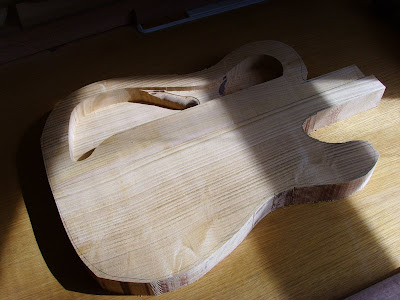Mmmm ... looks a bit thin for a guitar body ...

That's actually a bookmatched cherry cap. I managed to cut one of my pieces of cherry in half (lengthways) with a bandsaw, and then thickness both parts down to just under 10mm. Plenty thick enough for a cap, and thick enough for a bit of shaping on the cap too.
Can you guess what it's going to be yet ...

This might not be the standard shaped chamber for a thinline Tele, but I don't see why it wouldn't work just as well. Plus, I wanted to leave plenty of the body there to glue the cap to. This is my first attempt at a build like this, so I'm playing as safe as possible.
A slight cheat here, in that I'm using a bought-in neck blank. Sapele (not a favourite wood of mine). Still, the faces all needed planing before use, so it's not a complete cheat.
Here the truss rod slot has been cut, and the truss rod fits in nicely

Then you saw it, now you don't ... a fillet covering the truss rod in its slot. First job of today will be to glue the fillet in place, then to plane it down smooth with the face of the neck.

And when it's all planed and smooth, I'll cut out the neck shape, before fixing the fretboard on top. And one fretboard, slotted and ready to go.

It was quite a busy day in the workshop yesterday. Too much beer (is that possible?) combined with a half a bottle of red wine last night has resulted in a slightly sore head this morning ... so today's progress will be limited.
 And, after being clamped in place for a few hours, here's the neck with the fretboard now fixed in place too.
And, after being clamped in place for a few hours, here's the neck with the fretboard now fixed in place too.















